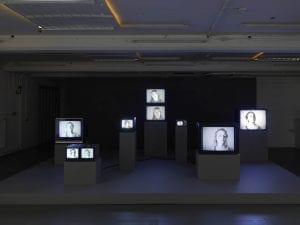The National Portrait Gallery, founded in 1856, is one of the world’s foremost galleries with 250,000 photographs 130,000 negatives in their collection. Since 2007, the NPG has hasted the Taylor Wessing Photo Portrait Prize. It is an award that showcases the work of talented emerging photographers, gifted amateurs and established professionals who are presenting the very best in contemporary photography. Previous winners include Abbie Trayler-Smith, Alys Tomlinson and Hendrik Kerstens. The award is often a vital platform for emerging artists, helping to propel their careers forward on a national and international stage. This year’s prize winners include Steph Wilson, Adam Ferguson, Tjitske Sluis and Jesse Navarre Vos. They were narrowed down from 5,000 submissions, and together they represent how the medium can be used for social activism and shine a light on the realities of 21st century life.

Steph Wilson’s portrait, Sonam, is the overall winner of this year’s prize. The image is part of a series documenting unconventional and “imperfect” examples of motherhood. Wilson put a call out for a-typical mothers who were willing to be photographed and share their experiences of being a parent. Sonam stares directly at the camera, unsmiling and in a wide-legged sprawl. Mother and baby are both entirely naked, unabashed in their nudity. Her closely cropped hair and moustache make for an unexpectedly masculine likeness, although the facial hair is actually false. It is both a statement of her career as a wig maker and a reminder to her experiences of being told she has masculine features by friends and family. Through this work, the artist balances, blends and broadens conversations on parenthood and gender.

Australian photographer Adam Ferguson’s project Big Sky was taken over the course of 10 years. It depicts the impact of globalisation, climate change and colonial legacies on the Australian Outback. The “bush” spans over two million square miles and dominates 70% of the country’s total land mass, and is often romanticised in novels, poems and songs. Ferguson pushes against these ideals, showcasing an environment in decline. He photographs a pastor at an Easter service, reflecting on the Lutheran missionaries who established Christian communities in this remote part of the country a century ago, transforming the nomadic life of indigenous populations forever. Elsewhere, two Indigenous women sit overlooking the vast landscape, wearing t-shirts emblazoned with global popstar, Taylor Swift. The photograph explores the tension between fantasies of the Outback depicted in history and popular culture, with encroaching commercialisation.

Dutch photographer Tjitske Sluis brings mortality to the fore in the series Out of Love, Out of Necessity. Sluis was drawn to the storytelling power of photographs, having previously worked as a journalist. The pictures show the artist’s mother, Teuntje, in the final stages of her life, which is captured with intense vulnerability and intimacy. Despite her frail form, Teuntje’s “infectious spirit” is echoed through her bold lip-patterned jumper. The overriding feeling is one of trust, demonstrating the bonds of kinship and resilience in the face of declining physical health. The work is also a testament to the power of art to make real, tangible change in the world. It is photography as social activism in action. The series was initially published in the De Volkskrant newspaper and directly engaged with the ongoing care crisis in the Netherlands, prompting a debate in the Dutch Parliament. Sluis was empowered through photography to bring about meaningful change, and she is now pursuing a master’s degree in care ethics.

The Prize’s longlist boasts a huge variety of talent from across the world. For example, Sandra Nagel uses the lens to expand the realms of fashion photography, capturing subjects with honesty, authenticity and grace through an appreciation of beauty in all its forms. The images document and celebrate the intimate nature of youth culture, as well as ultimately calling for social change. The centring of a community is echoed in Latoya Okuneye’s work All eyes on me, which depicts the liberation of the body. The Black experience is key to the narrative, as is the potential to celebrate the body. Okuneye casts a non-binary model to challenge gender constructs. Meanwhile, Nick van Tiem, plays with colour to create scenes that feel as though they’ve jumped from the page of a comic book, with unique locations and graphic narratives.
Each of the winning portraits are on display until 16 February at the National Portrait Gallery, London alongside works by over 50 additional lens-based artists. Showing currently is Diana Markosian’s Father. Markosian’s work is at the forefront of a new generation of photographers, pushing the boundaries of documentary storytelling. Visitors will traverse deeply personal stories, stepping into different lives and seeing the world through new eyes.
The Taylor Wessing Photo Portrait Prize 2024 runs until 16 February 2025: npg.org.uk
Words: Emma Jacob
Image Credits:
Slo, Mzwandile and Andile opening the trunk of the BMW, Kloof Nek Road, 2024 from the series It was never meant to be easy (2024) – A Broke Boys story by Nick van Tiem © Nick van Tiem.
Phebe, 2024 by Sandra Nagel © Sandra Nagel.
Sonam by Steph Wilson from the series Ideal Mother, 2023 © Steph Wilson.
Cousin sisters Shauna and Bridget Perdjert, Kardu Thithay Diminin Clan and Murrinhpatha language group, Kardu Yek Diminin Country, Air Force Hill, Wadeye, Northern Territory, 2023 by Adam Ferguson from the series Big Sky, 2023 © Adam Ferguson.
Ardhnarishwar, 2023 from the series Postcard Inlandia by Tanmay Saxena © Tanmay Saxena.





